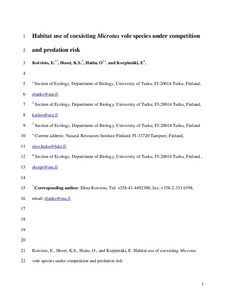Habitat use of coexisting Microtus vole species under competition and predation risk
Katrine S. Hoset; Erkki Korpimäki; Otso Huitu; Elina Koivisto
https://urn.fi/URN:NBN:fi-fe2021042717250
Tiivistelmä
Competing species and predators can alter the habitat use of animals, but both factors are rarely simultaneously controlled. We studied in experimental enclosures how closely related species, the sibling vole (Microtus levis Miller, 1908) and the field vole (Microtus agrestis (Linnaeus, 1761)), adjust their habitat use when facing either the competing species or simultaneously competition and predation risk. The species responded differently in their proportional use of two habitat types, a low cover (productive but riskier) and a high cover (safer but poorer). When alone, field voles used the low-cover habitat according to availability at low densities, but decreased its use with increasing density. Sibling voles, however, avoided the low-cover habitat in single-species populations. Under interspecific competition, the habitat-use patterns switched between species: sibling voles used the low-cover habitat according to availability, with decreasing use as densities increased. Sibling voles responded to predation risk by showing a stronger density-dependent decrease in the use of low-cover habitat. Field voles, initially using mostly high cover, did not change behaviour under risk of predation. Our results highlight the importance of considering both predation risk and interspecific competition when interpreting patterns of habitat selection among coexisting species.
Kokoelmat
- Rinnakkaistallenteet [19207]
